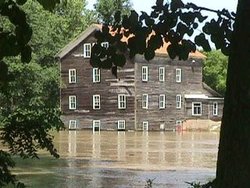Eel River (Indiana)
|
|
There are two Eel Rivers in Indiana. Both are tributaries of the Wabash River. One flows through Cass, Miami, Wabash, Kosciusko, Whitley, and Allen Counties and was historically called Ke-na-po-co-mo-co. The other flows through Greene, Owen, Clay, Putnam, and Parke Counties and flows into the White River which is a tributary of the Wabash.
| Contents |
Northern Eel River
Eel_River_Collamer_Dam_1998.jpg
Called Ke-na-po-co-mo-co or "river of the snake fish" by Native Americans, the Eel River is a tributary of the Wabash River in Indiana. It was later called the L'Anguille River. It rises southeast of Huntertown in Allen County and flows southwest 110 miles to join the Wabash at Logansport in Cass County.
Origins and History
Originating as an ice-marginal channel at the edge of the retreating Saginaw Lobe of the Wisconsin Glacier, the Eel River was later buried by the glacier's advancing Erie Lobe. As the Erie Lobe retreated, the Eel formed a single stream with what is now upper Cedar Creek in DeKalb and Allen counties. This ancestral Eel River was also fed by glacial meltwater surging under the ice from the southeast through a tunnel valley known today as Cedar Creek Canyon. Blockage of the Eel's channel by outwash from the canyon and a decline in the volume of meltwater forced the upper Eel to change course into the canyon, creating today's Cedar Creek. This is a classic example of stream piracy that shifted almost 175,000 acres (708 km²) of land from the Eel-Wabash watershed to that of the St. Joseph-Maumee.
Before the United States consolidated its hold on the Northwest Territory, the Eel formed a rough boundary between the Potawatomi tribe on the north and Miami tribe on the south. During the Revolutionary War, a Continental force under Auguste Mottin de la Balme, who planned to seize a British trading post on the Eel near present-day Columbia City, was destroyed by the Miami under Chief Michikinikwa, also known as Little Turtle. On October 19, 1790, Michikinikwa's warriors surprised and virtually annihilated a U.S. force under Colonel John Hardin in the Eel bottomlands southeast of present-day Churubusco. In 1791, the Eel was the scene of yet another battle, when General James Wilkinson destroyed the Miami town of Kenapacomaqua seven miles upstream from present-day Logansport. In September 1812, Colonel James Simrall, acting under orders from General William Henry Harrison, ravaged Miami farms and villages along the Eel in present-day Whitley County, defeating a Miami force that stood and fought.
Literary Reference
- Johnny Shawnessy probably had a better guess about the river's name than anyone else as he was the only person in the County for years who made any research into the Indian culture. He finally decided that the river's name was related to the Indian word "Shakamak," meaning long fish or eel. There was a Shakamak River in southern Indiana; and in the northern part of the state, an Eel River, which in the Miami tongue had been called the Kenapocomoko, or River of Snake Fish.
- The only drawback to Johnny's theory was the fact that he never found an eel in the Shamucky River.
--Ross Lockridge, Jr., Raintree County, Boston:Houghton Mifflin (1948), pp. 93-94. Copyright 1947 and 1948 by Ross F. Lockridge, Jr.
Southern Eel River
The other Eel River in Indiana flows from its head near New Brunswick in Boone County. It runs generally south and slightly west for most of its course until it takes a southeast turn about 4 miles west of Martz. It then flows about 18 miles to its junction with the White River near Worthington. One of its tributaries, Big Walnut Creek, has a drainage basin of 318 square miles. Another tributary is Mill Creek which flows into Cagles Mill Lake before joining the Eel.
External Links
- Sequential Development of Eel River and Cedar Creek (http://www.angelfire.com/in3/cedarcreek/origins.html)
- Little Turtle, the Great Eel River Chief (http://mcs.k12.in.us/histsoc/Nov02.htm#turtle)
- The Eel River Post and Fort (http://mcs.k12.in.us/histsoc/Aug02.htm#post)
- Along the Eel (http://mcs.k12.in.us/histsoc/Aug02.htm#eel)
- Introduction to the Eel River (http://mcs.k12.in.us/histsoc/May02.htm#eel)
- The Eel River of Northern Indiana (http://mcs.k12.in.us/histsoc/feb01.htm#eel)

